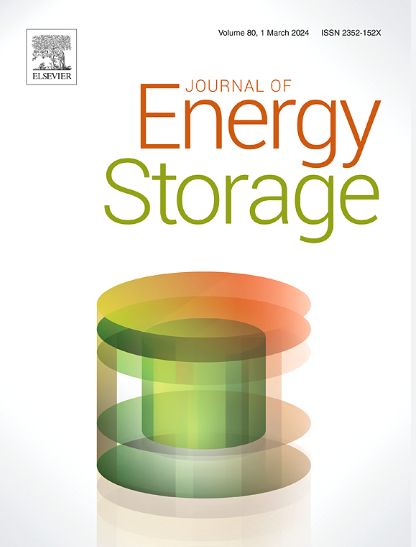绿色合成rGO@Pr₆O₁₁纳米复合材料:高效光催化降解罗丹明B,增强储能性能
IF 8.9
2区 工程技术
Q1 ENERGY & FUELS
引用次数: 0
摘要
为了寻求可持续能源解决方案和有效的环境修复,我们提出了氧化石墨烯(GO)和还原氧化石墨烯(rGO)纳米复合材料与氧化镨(Pr6O11)纳米颗粒的创新合成。这项研究强调了这些材料在解决关键的能源和环境挑战方面的重要作用。通过简单和环保的方法合成的纳米复合材料显示出出色的光催化效率,在180 min的阳光下,由于氧化石墨烯和还原氧化石墨烯的协同作用,其对罗丹明B的降解率达到99.33%,显著优于裸Pr6O11。此外,采用三电极和两电极配置进行的详细电化学评价表明,rGO@Pr₆O₁₁纳米复合材料具有较高的比电容。在三电极配置中,rGO@Pr₆O₁₁纳米复合材料表现出202.85 F/g的优越比电容(从CV测量),并在10,000次循环后保持其容量的89.52%。在不对称双电极配置下(rGO@Pr₆O₁₁为正极,活性炭为负极),该装置在5 mV/s (CV)下的比电容为53.42 F/g,在1 a /g (GCD)下的比电容为10.52 F/g,能量密度为3.34 Wh/kg,功率密度为1500 W/kg。Pr6O11和还原氧化石墨烯的混合设计通过改善离子传输和电子导电性来增强电荷转移,展示了它们作为储能和环境修复变革材料的潜力。本研究介绍了一种高效的纳米复合材料,它代表了光催化和能量存储方面的重大进步,在实际应用中具有广阔的前景。本文章由计算机程序翻译,如有差异,请以英文原文为准。
Green synthesized rGO@Pr₆O₁₁ nanocomposites: Efficient photocatalytic degradation of rhodamine B and enhanced energy storage performance
In the quest for sustainable energy solutions and effective environmental remediation, we present the innovative synthesis of graphene oxide (GO) and reduced graphene oxide (rGO) nanocomposites integrated with praseodymium oxide (Pr6O11) nanoparticles. This study underscores the vital role of these materials in addressing critical energy and environmental challenges. The nanocomposites, synthesized through a simple and eco-friendly approach, demonstrated outstanding photocatalytic efficiency, achieving 99.33 % degradation of Rhodamine B under sunlight within 180 min—significantly outperforming bare Pr6O11 due to the synergistic effects of GO and rGO. In addition, detailed electrochemical evaluations using both three-electrode and two-electrode configurations revealed that the rGO@Pr₆O₁₁ nanocomposites exhibit high specific capacitance. In three-electrode configurations, the rGO@Pr₆O₁₁ nanocomposites exhibit a superior specific capacitance of 202.85 F/g (from CV measurements) and retain 89.52 % of their capacity after 10,000 cycles. In the asymmetric two-electrode configuration (rGO@Pr₆O₁₁ as the positive electrode and activated carbon as the negative electrode), the device delivered a specific capacitance of 53.42 F/g at 5 mV/s (CV) and 10.52 F/g at 1 A/g (GCD), with an energy density of 3.34 Wh/kg and a power density of 1500 W/kg. The hybrid design of Pr6O11 and rGO enhances charge transfer through improved ion transport and electron conductivity, demonstrating their potential as transformative materials for energy storage and environmental remediation. This research introduces a highly efficient nanocomposite, representing a significant advancement in photocatalysis and energy storage, with promising implications for practical, real-world applications.
求助全文
通过发布文献求助,成功后即可免费获取论文全文。
去求助
来源期刊

Journal of energy storage
Energy-Renewable Energy, Sustainability and the Environment
CiteScore
11.80
自引率
24.50%
发文量
2262
审稿时长
69 days
期刊介绍:
Journal of energy storage focusses on all aspects of energy storage, in particular systems integration, electric grid integration, modelling and analysis, novel energy storage technologies, sizing and management strategies, business models for operation of storage systems and energy storage developments worldwide.
 求助内容:
求助内容: 应助结果提醒方式:
应助结果提醒方式:


